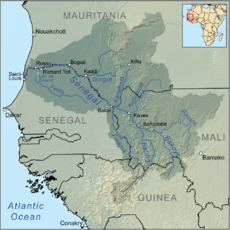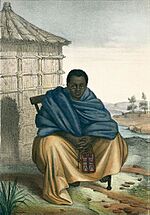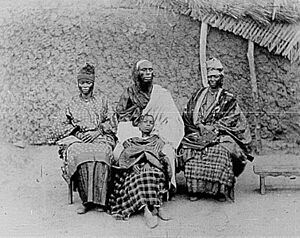Toucouleur people facts for kids
| Haalpulaar هَالْݒُلَارْ 𞤖𞤢𞥄𞤤𞤨𞤵𞤤𞤢𞥄𞤪 |
|
|---|---|
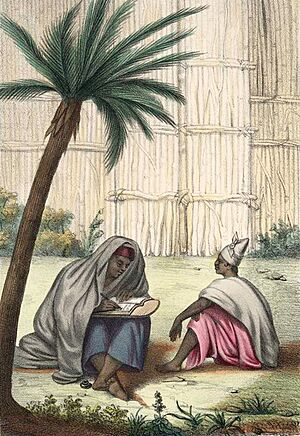
A Tukulor man and woman
(1853 David Boilat painting) |
|
| Total population | |
| 1 million (2010) | |
| Regions with significant populations | |
| Senegal The Gambia Mali Mauritania |
|
| Languages | |
| Pulaar and French | |
| Religion | |
| Islam | |
| Related ethnic groups | |
| Serer, Wolof, Fula |
The Toucouleur people or Tukulor people are an ethnic group from West Africa. They mostly live in the Futa Toro region of Senegal, near the Senegal River. You can also find smaller groups of Toucouleur people in Mali and Mauritania. They are also known as Haalpulaar.
The Toucouleur people became Muslims in the 11th century. Being Muslim is a very important part of their identity and something they are proud of. They were among the first groups in the area that is now Senegal to adopt Islam. They played a big role in spreading Islam across West Africa during the medieval times. In the 19th century, they even created a large empire called the Toucouleur Empire. This empire was led by Omar Saidou Tall.
Traditionally, Toucouleur people live in one place, mostly in the Senegal River valley. Their main jobs are farming, fishing, and raising cattle. Their society has been organized in a way where the father's family line is most important. There are about 1 million Toucouleur people in West Africa today.
Where Toucouleur People Live
Most Toucouleur people live in the northern parts of Senegal. They make up about 15% of the population there. This area is watered by the Senegal River and also stretches into southern Mauritania.
During the time when European countries ruled Africa, and even today, some Toucouleur people moved to western Mali. There are about a million Toucouleur people in the Senegal River valley area. Around 100,000 Toucouleur people live in Mali.
Names and Language
Besides Toucouleur, people sometimes call them Torooɓe, Futanke, or Haalpulaar. The name Toucouleur might come from a French word meaning "of every color." However, it's more likely that it comes from tekruri, an old term for "people from Takrur" (an ancient kingdom).
Some people used to think that Toucouleurs and Fula people were very different. This idea came from French researchers in the 1800s. They thought Toucouleurs were settled farmers who were very religious and didn't like Europeans. They thought Fula people were nomadic herders who were easy to work with. But this idea isn't really true. Toucouleur people are a part of the larger Fula group.
Toucouleur people speak a language called Pulaar. This language is a dialect of Fula. Fula is part of the Atlantic branch of the Niger-Congo language family.
History of the Toucouleur People
According to the old stories passed down by the Toucouleur and Serer people, the Toucouleurs are related to both Serer and Fula ancestors. Many experts agree with this tradition. The Serer and Toucouleur people also have a special friendly relationship where they can joke with each other.
The Toucouleur people have lived in the Senegal River area for a very long time. There was an organized kingdom called Tekrur in this area as far back as the 5th century. The Toucouleur were part of this kingdom from the 10th to the 18th century. However, during much of that time, rulers from other ethnic groups led the kingdom.
In the 18th century, a Toucouleur empire started to grow. It became very powerful in the 19th century under a Muslim leader named Omar Saidou Tall. Omar was born into a Toucouleur religious family in 1797. He traveled to Mecca in 1827 and was given the title "Caliph of Black Africa." When he returned to West Africa in 1833, he learned important strategies for building a state from his father-in-law.
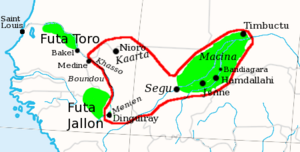
Omar came back to Senegal in 1845. He started teaching about Islam among the Toucouleur people. He bought weapons from Europe. Then, in 1854, he gathered the Toucouleur people to fight a holy war. This war was against groups who were not Muslim and against Muslims who had moved away from the faith. The Toucouleur armies were successful.
The Toucouleur Empire grew and spread from Senegal into much of Mali over the next ten years. After Omar's death, his son Mustafa ruled the empire from 1864 to 1870. Then, Omar's second son, Ahmadu Tall, took over. Ahmadu's rule was described as a strong Toucouleur-Muslim leader over the Mandinka people and Bambara people.
The empire started to fall apart in the 1880s. Other groups like the Fulani, Tuaregs, and Moors attacked the Toucouleurs. There was also a civil war among local Toucouleur leaders. The empire finally ended in 1891 when French colonial forces took over the region.
Toucouleur People and Their Society
The Toucouleur people speak the Futa Tooro dialect of Pulaar. They call themselves Haalpulaar’en, which means "those who speak Pulaar." They are Muslims. One way the Toucouleur people are different from other Fula groups is that they tend to live in settled communities rather than moving around a lot.
Social Groups
Toucouleur society is organized around the father's family. It has a clear system of different social groups, or castes. These groups are very strict.
The highest group among the five Toucouleur castes is the Torobe. These are the noble leaders and Islamic scholars. Below them are the Rimbe, who are administrators, traders, and farmers. The Nyenbe are the skilled workers and artisans in Toucouleur society.
The fourth group is called the Gallunkobe. These are people who were once slaves or are descendants of slaves who have been freed. The lowest group among the Toucouleurs is the Matyube, who are slaves. People became slaves by being captured from other groups, bought in markets, or by inheriting the status from their parents.
This system of social groups has meant that wealth and opportunities were not shared equally. Historically, only members of the upper castes owned property and land. People usually inherit their jobs and their place in society. People from different Toucouleur castes rarely married each other. Religious leaders among the Toucouleur, like those among the Wolof people, formed a separate group. While becoming a religious leader wasn't always inherited, it was rare for someone from a lower caste to become one. This was because they were often seen as not being religious enough.
Marriage Traditions
When a Toucouleur couple gets married, the groom's family usually pays a bride price to the bride's family. If the girl is from a high-status family, like a noble family, her family expects a much higher payment. This is more than what would be paid for someone from an artisan family or a family with slave ancestors.
The marriage is officially recognized at a mosque. The bride then moves to live with her husband's extended family. In the past, before the marriage was completed, the bride's aunt would check if the girl was a virgin. Then she would bathe and massage her. After this, the bride and groom would join a wedding celebration. All the people from the village would join in to celebrate the new couple.
Childbirth and Naming a Baby
One week after a baby is born, during a ceremony called pémbougale, the baby is named. A gorgol, who is the father's sister, cuts the baby's hair. The father tells the marabout (a religious teacher) the name he has chosen. The marabout then whispers the name into the baby's ear and says a prayer.
After this, the marabout tells a gawlo (griot, a storyteller and musician) the chosen name. The griot then announces the baby's name to everyone in the village.


